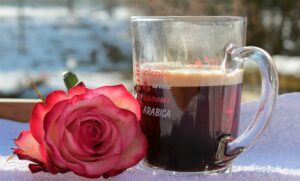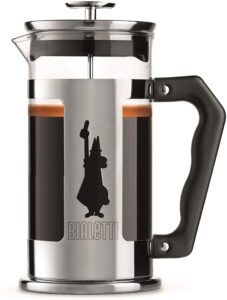Last updated on May 20th, 2024 at 11:50
Colombia is famous for its high quality coffee and this article is dedicated to showing you how to make Colombian coffee.
You will learn what Aguapanela is, how to make it, what tinto coffee is and how to make it like a Colombian!
I’ll also talk about how Colombians drink their coffee.
Keep reading and let’s crack on with this article.
How Do Colombians Brew Coffee?
Table Of Contents
Colombia, alongside Brazil, is one of the most famous coffee growing nations in the world, both in terms of quantity and quality.
Coffee cultivation dates back to the 1700s and this, with 300+ years as a producer of coffee, it is of little surprise that they know how to grow high quality coffee beans and produce the finest coffee. If they didn’t. Something would be wrong, very wrong if they did not know how to grow amazing coffee cherries after 3 centuries of coffee farming.

Read: What is Colombian coffee?
How Colombians Brew Their Coffee
In Colombian homes you will find a colador and an oletta. A colador is a cloth filter with a wire around the rim.
Brewing coffee with a cloth filter is very easy and much better than a paper filter as it leaves some coffee oils in your brew, whereas a paper filter will remove all the coffee oils.
Simply add a good dose of coffee grinds to the cloth filter and pour your hot water. It is the simplest method of brewing coffee.
Colombians will often brew a batch of coffee in the morning and reheat it throughout the day. If you want a fresh coffee made this way, make it to your Colombian friend’s house early in the morning!
The olleta is an aluminum pot in which the water is boiled and coffee grinds thrown in and boiled for a while and poured into your cup filter free.
The most popular coffee preparation technique in Colombia is agua panela, which, as a direct translation, is panela water, water boiled with raw sugar cane.
There are variations of this coffee with ginger and cinnamon for a greater coffee taste, something coffee aficionados love.
You’ll see in coffee shops machines called grecas, tall shiny espresso machines that make what can only be described as strong, but burnt coffee, it is the kind of coffee that has been drunk in Colombia for centuries.

Read: What is the difference between Arabica and Colombian coffee?
How To Make Colombian Coffee Like A Native!
In my humble opinion, there is no such thing as a bad coffee. This is subjective, some coffees are better than others and, unfortunately, it used to only be the bad coffee beans that made their way into the local market in Colombia.
The best quality was kept, for export where a higher price was demanded. In 2003, this changed and some better quality coffee berries were being sold in Colombia.
What Is Tinto Coffee?
In Colombia there is a distinction between what they call coffee and what they call tinto. Tinto is literally translated to ink, or literally inky water. If you are familiar with Castilian Spanish from Spain (as I am) you’ll recognize the word in its use to identify red wine “vino tinto”.
The same, it’s based on the color.
Tinto is thicker, more focused and concentrated coffee that is made with lower quality coffee beans and is what you will find in a coffee shop.

How To Make Tinto Coffee
Tinto coffee is made by boiling ground coffee in an aluminum pot with boiling water with lower quality coffee beans from popular local brands like Sello Rojo. Once brewed, you can see Tinto sold on the streets in thermos flasks up and down the whole country.
What Is Aguapanela?
Aguapanela is water boiled with raw chopped sugar cane and boiled until the sugar cane boils. During the process, coffee is added.
Equipment
- Aluminum coffee pot.
- French press.
Ingredients
- 40 Ounces (1.2 liters) of water.
- 12 Ounces (360 grams) Panela (raw sugar cane) chopped into small pieces
- 2-3 Tablespoons (10 to 15 grams) of freshly ground Colombian coffee grounds. Coarse grind size is best.
The Method
Put your water into the pot and bring it to the boil. While your water is boiling, chop your panela into small pieces and place them into your water. Let your water simmer for half an hour or so until the panela melts. Stir well during the process to stop it sticking.
When it is ready, take your water off the heat and let it cool for 5 mins.
Put your coffee grounds into your French press and shake your press to ensure even distribution of your grounds.
Pour your hot water onto your coffee grounds until the grounds are damp and just covered. Wait 20 to 25 seconds to allow your grounds to bloom.
Once your grounds have bloomed, pour the rest of your water into your French press until it is full. Stir your grounds for a minute. Press down on your plunger until it is just below the water line.
Wait for 3 to 4 minutes for your grounds to extract. Test to see if your coffee is brewed and well extracted. If it is, press slowly and down evenly on your plunger and pour your coffee and enjoy.
If you have any coffee left in your French press, decant it to another container as it will continue to extract and overbrew.

How To Make Aguapanela Con Leche
Follow the same step-by-step instructions and simply add milk to your coffee. After you pour it.
How Do Colombians Drink Their Coffee?
Colombians like to start their day with a small cup of coffee known locally as a tinto. A tinto is not a strong coffee. Those that want a stronger coffee will start with an aguapanela, which is a sweet and sugary start to the morning.
Typically, as I noticed, they will drink tinto all day and literally all night, even late into the night. Be careful of what you ask for in Colombia, as coffee and café are very different. If you ask for coffee you will likely get a tinto or an aguapanela (if stated) but a café is a coffee with milk, literally a cup of milk with a dash of coffee. It’s very milky and has only a tiny bit of coffee.
Frequently Asked Questions About How To Make Colombian Coffee
What Makes Colombian Coffee Different?
Colombian coffee is mostly Arabica coffee beans which are known for being the coffee beans that produce the best flavor. They are lighter and sweeter. Colombia has the ideal, almost perfect conditions for the cultivation of this type of coffee bean, including the altitude, climate and top quality mineral-rich volcanic soil, which produce a flowery taste that is highly desirable.
Why Is Colombian Coffee So Smooth?
Colombian coffee is very smooth due to the way in which the country processes their beans. The majority of the beans are wet processed.
Why Is Colombia Coffee So Good?
A number of factors contribute to great coffee, a large part of that is the skill of the coffee farmers. They are highly experienced and know how to take advantage of the perfect climate of plenty of sunshine and rainfall and high quality mineral-rich volcanic soil. The industry from top to bottom kno how to process and roast their coffee to produce a great final product.
It’s not just one single factor but a combination of many parts of the process.
Is Colombian Coffee 100% Arabica?
Yes, colombian coffee is 100% Arabica coffee beans. Although the country could grow robusta, they don’t. Market conditions as well as the climate and elevation dictate that it is much better and more profitable to grow Arabica coffee.
What Do Colombians Put In Their Coffee?
Colombians love to enjoy a small cup of coffee in the morning with panela or regular sugar. Panela is a raw sugar that is common all over South and Central America to put in coffee.
Which Is Better Colombian Or Brazilian Coffee?
With a respect that a genuine and honest coffee lover can give, Colombian coffee is much better than Brazilian coffee. Even though Brazil is known as the number 1 producer of coffee in the world producing twice as much coffee as second placed Vietnam, they are known for producing low to average quality coffee.
Frappé-Ing It All Up, How To Make Colombian Coffee
There is no doubting the quality of Colombian coffee and the ability of coffee growers to grow, cultivate, process and roast the product of the coffee cherry.
All you need to know is how to make Colombian coffee in the authentic way that locals do with the beans that they use, and you will get an awesome coffee the way that Colombians love it.
Make it as outlined in this article, brew a tinto of aguapanela!
Join our cool coffee community and take part by sharing your coffee creations, eye-catching latte art and delicious coffee recipes. Be sure to post those funny memes and coffee jokes. Find us on Facebook/Meta.






![[Recipe] How To Make Dunkin Iced Coffee At Home Like A Pro!](https://lattelovebrew.com/wp-content/uploads/2022/04/Recipe-How-To-Make-Dunkin-Iced-Coffee-At-Home-Like-A-Pro-1024x576.jpg)
